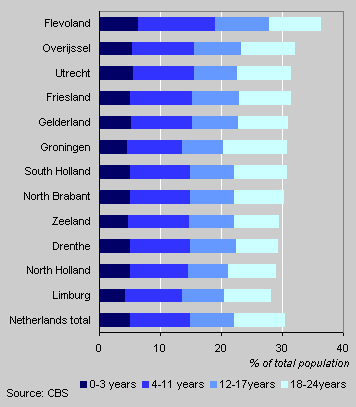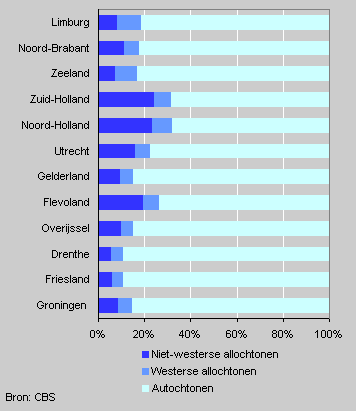Youngest province, youngest population

The proportion of young people in the population is largest in the province of Flevoland: nearly four out of every ten inhabitants of this province are younger than 25 years.
Young people per province, 2003

Provinces with many children
Half a century ago, families in the south of the country had more children than families in the north. Around 1950 the number of births per thousand inhabitants in the southern provinces of North Brabant and Limburg was about one quarter higher than in the northern provinces Groningen and Friesland.
This north-south divide has ceased to exits. Today, fewest children are born in Limburg and Groningen, while most babies are born in the provinces of Flevoland, Drenthe, Friesland and Overijssel. Flevoland is now the province with the largest share of young people in its population.
Young people by province and ethnic origin, 2002

Young Flevoland
It is not only the increase in the number of births that has rejuvenated Flevoland. Internal migration also played part: the city of Almere in particular attracted many young families and young couples who wanted to start a family.
Internal migration was also the reason why the relatively infertile province of Groningen is younger than average. Here there is an overrepresentation of 18–24 year-olds because of the colleges and university there. Nearly 11 percent of the population of Groningen is in the age category 18–24 years, more than in neighbouring Drenthe (7 percent).
Many children in smaller municipalities
The composition of the young population differs between small and large municipalities. There are relatively more children of primary and secondary school ages in smaller municipalities, while there are more young adults aged 18-25 years in municipalities with 100 thousand or more inhabitants. This pattern is especially clear in municipalities with universities and vocational colleges, such as Groningen.
Young people by size of municipality and ethnic origin, 2002

Relatively many people with a non-western foreign background live in the western provinces and in the large cities. As these groups have a higher birth rate, this phenomenon is even more clearly observed for young people with a non-western foreign background: this group accounted for a four times larger share of the population in South Holland than in Drenthe. In municipalities with more than 100 thousand inhabitants the share is eight times as high as in municipalities with fewer than 10 thousand inhabitants.
The distribution of non-western foreigners across the provinces is partly an inheritance from the 1960s and 1970s. Relatively many Turks live in the east of the country. This is because many low-educated Turks originally came here to work in the manufacturing centres in the provinces of Overijssel and North Brabant.
Joop Garssen